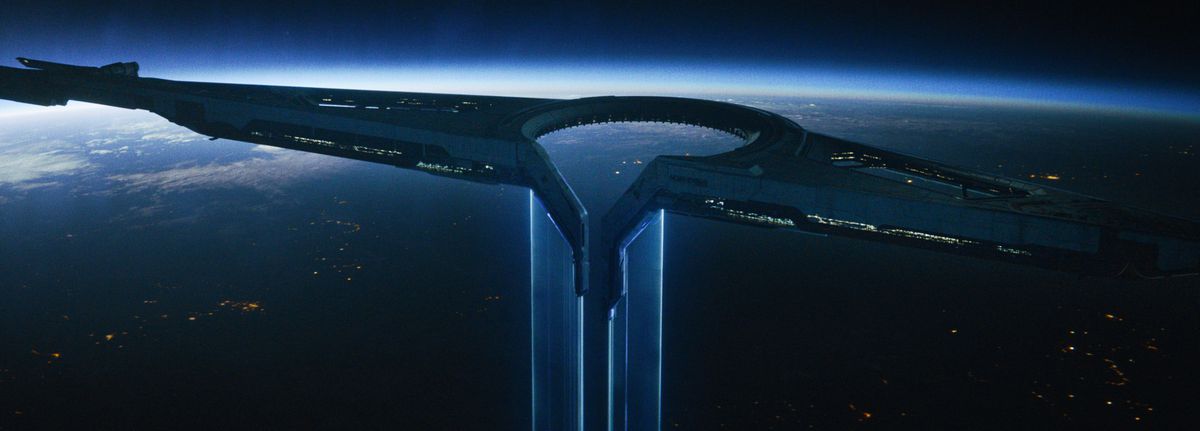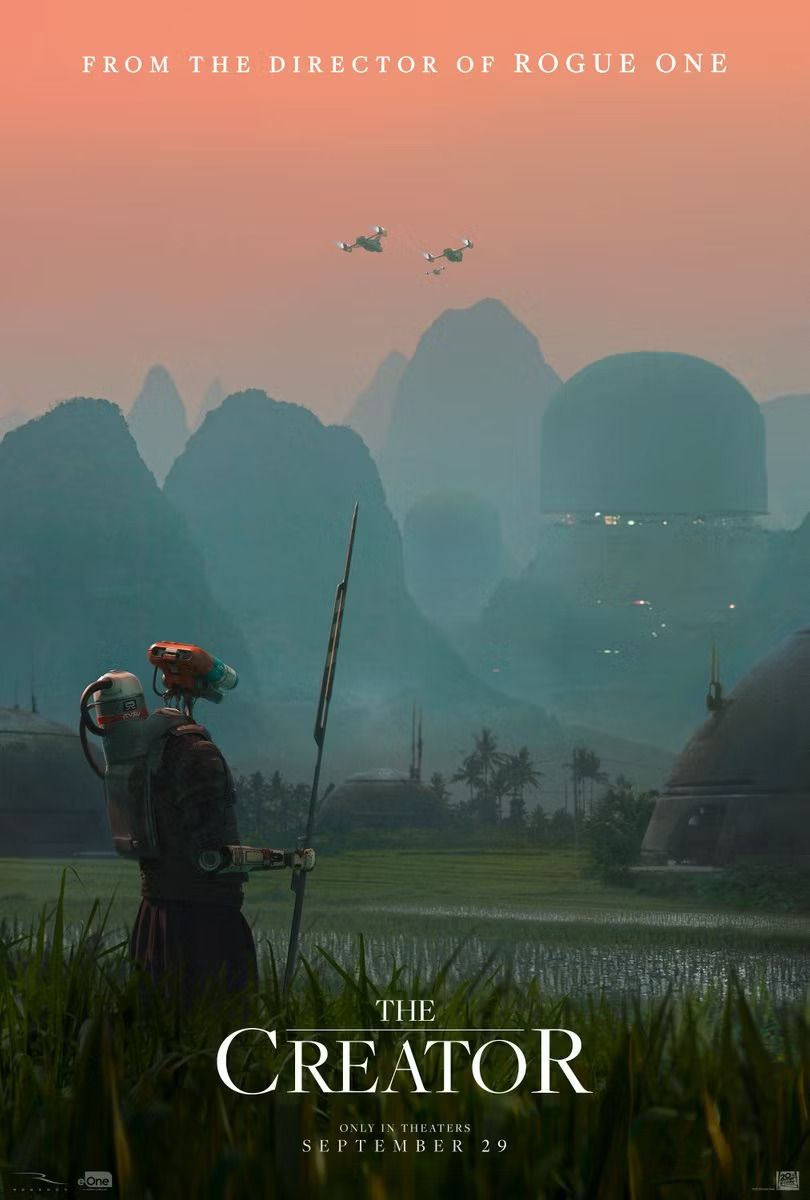How insects, Akira, and Pink Floyd shaped The Creator’s eerie robot designs
The creator is unlike anything else in theaters right now. Although it obviously expands on previous visuals from films like Apocalypse now, Blade RunnerAnd Akirathe latest sci-fi action film from Thief One Director Gareth Edwards also feels indebted to the mood and spirit of our contemporary reality, thanks in large part to Edwards’ decision to film on location in eight different countries, including Nepal, Cambodia and Thailand .
The film is distinguished from its contemporaries by its strong emphasis on strong artistic direction, grounded in an emphasis on tactile retrofuturism. This is evident in everything from the costumes and robot designs to the sinister, jagged silhouette of NOMAD, the low-orbiting nuclear warship that hovers in the sky for most of the story. The creator.
Via Zoom, Polygon spoke to The creatorProduction designer James Clyne to talk about how he and Edwards refined their work. The creatorthe unique aesthetic of. We discussed the importance of graphic design in world building and how the 1982 film Pink Floyd The Wall inadvertently inspired the design of NOMAD.
Polygon: What was it like working with Gareth Edwards on the aesthetic of The creator? What were your visual and philosophical guiding principles for the look and feel of this particular universe?
James Clyne: That’s a big question. I mean Gareth, on many levels he is very involved in his cinema. He loves handling the camera, he loves being involved on all levels, including art and creating what this world could be. So a lot of our initial discussions were just influences, what were we influenced by? We’re a bit the same age. We grew up in the 80s with all these great sci-fi movies like Total recall And Blade Runner. But we are also influenced by films like Apocalypse now.
There is one specific film that stood out – Baraka. In a way, we watched this movie and thought: And if Baraka was made 60 years ago, and we got to watch it today? What would that look like? What does it mean, what does it do? Because Baraka is a wonderful documentary about today’s culture, about humanity, where we are, where we have been and where we are going. And Gareth has a certain documentary sensibility, in the sense that he just wants to go to a place and film it as it is. That’s a lot of what we did in the film: go to these real-life locations in Southeast Asia and take beautiful photos.
So that was one thing that we knew we wanted the film to be based on, these very exotic natural locations. And then we asked what kind of world we wanted to build from that, which was another big discussion. As we were in Southeast Asia, we were influenced by 90s Japanese culture and the way they built their technology. Walkmans, televisions and stereo equipment, they all had this very tactile look. We are so used to iPads and iPhones – a sheet of glass laminated to a metal backing. We just thought it wouldn’t be the most cinematic thing.
So we thought, What would a Walkman look like in 60 years? How can we keep it tactile, with real buttons and real LED screens, while making it our own future? What if this 90s technology went in a different direction and we still used high-touch equipment? This plays into everything from costume and prop design to vehicle design to the design of NOMAD itself.
Image: 20th Century Studios
The robots in this film are fascinating, especially the insectile facial structure of the older generation robots with their pincer-like mandibles, compared to the newer “Simulant” models. How did you choose these two models?
For everything about this film, we started with very rough sketches, whether in a sketchbook or working on a computer. We wanted to keep things free. This insectoid look came about where we didn’t want them to look humanoid, but we wanted them to display their own evolutionary process. As if a certain animal evolved over millions and millions of years to become something else. What if robots took the initial idea of the human form and evolved into something else? We just stuck with a more insectoid appearance. The insects themselves almost feel like they are made from another material; they are not made of flesh. It just seemed appropriate for our designs.
With the Simulants, there was a desire to ensure that they could emit emotions like humans, so when we look at Alphie, or we look at his room, as an audience we feel what they feel. But when they turn their heads, there is a hole in their head that goes all the way through. There is a cavity at the back of the head that is fully exposed, this is impossible to do with just makeup. The current design language goes back to this idea of retrofuturism, of old technology mixing with new technology. Maybe there’s a battery that charges at the back of the head, that emphasis on the physical and tactile elements, rather than that more gimmicky, almost Minority report version of the future. Which I also think is cool, but we wanted to take this different approach and make it more grounded in some sort of reality.
Another interesting robot design was that of the suicide bomber androids that the US military deploys towards the end of the second act, with the way they salute their commanders before speeding off to kill their targets. What was the thought process behind this?
We wanted to create something that, even if he stood there and did nothing, would intimidate the audience and make them leave. It’s not a robot, it’s a bomb. The best shape we could achieve was a sort of large cylinder. It looked like something that would be dropped from an airplane or fired from the barrel of a tank or battleship gun, but it happened to have legs and arms. We didn’t want to create something so abstract that the public wouldn’t understand that this thing was going to explode, so we put warning tape on it and other graphics that gave off the idea of ”Don’t mess around.” with this thing. »We wanted to make it cool, functional and believable.

Image: 20th Century Studios
You mentioned the design of NOMAD, the flying nuclear warship that hovers like a sword in the sky for most of the film. This is one of the most striking designs of The creator. It reminded me a lot of the orbital laser of Akira, and I know Edwards has compared him to a “bird of prey” in interviews. What was the inspiration behind this?
I think a sword is a great analogy for what NOMAD is, which is a weapon. We made thousands of sketches and brainstormed aggressive and intimidating shapes. I remember being a little frustrated trying to understand the design sense of NOMAD, so I sent Gareth a still from this film called Pink Floyd The Wall. I saw it when I was a kid, and it really messed with my head. Some truly disturbing images of war, including this raven-shaped bird of prey that flies over the landscape in search of unsuspecting prey. There were some really harsh and aggressive responses.
Gareth really liked the idea of NOMAD looking like this massive eagle in the sky that slowly circles around its prey. Once we had that metaphor, we were able to take the design further, making it almost shaped like a head or fangs – these very strong wings that stick out on either side. Hopefully this will come across when the public sees this, without any context, that this weapon is aggressive and should be kept away from it.
This goes into great detail, but I love the design of the title cards for this film. When I noticed the little “Nirmata” logo in the corner, I thought: Wait, are we actually watching an in-universe propaganda film about the events of The creator? What was planned in the design of these?
I really like this idea. (Laughs) I thought these title cards were beautiful. These were made quite late in production and I can’t speak to the design itself. But what I can talk about is Gareth’s love of graphics and typography, which is present throughout the film, from the police vans to the large door that Joshua opens to find Alphie. Gareth not only had an eye for set design, but also graphic design.
I think sometimes it’s often overlooked, and you can tell in a film when it’s overlooked. We paid a lot of attention to the size of the logos, such as the tank (the US is deploying to attack the AI complex). There are little logos everywhere that give the idea that there is a manufacturer that built the tank, so they put their name right on the side to make themselves known. All these details you may not see on the first viewing, but hopefully these details will show up on a second or third viewing.

Image: 20th Century Studios
One of my favorite aspects of The creator This is the film’s emphasis on artistic direction, and it’s especially evident in the film’s teaser poster. Key art of this robot standing in a field with bulbous structures in the background and a bright pink sky. Do you know who designed this illustration?
Well, I know, because it’s me. (Laughs) I can’t take all the credit for this; Disney came up with some ideas. But Gareth and I sat down and said: OK, what are the most favorite elements that we want to have here? Disney made the final pass, but I did these first sketches of a robot with structures in the distance. We just figured out what type of posters we were attracted to and what elements we wanted to highlight in the film.
